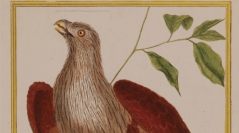Georges-Louis Leclerc de Buffon and his collaborator Philibert Guéneau de Montbeillard (hereafter Guéneau), published a monumental nine-volume Histoire naturelle des oiseaux (“Natural history of birds”) from 1771 to 1783, as a part of a more general, unfinished project of a complete description of nature. It was the most exhaustive work on birds of its time, dealing with all the species then known, and describing a lot of new species present, among others, in the rich collection of the Cabinet royal (the institution renamed “Muséum national d’Histoire naturelle” in 1793). This collection, now almost completely lost, included many specimens inherited from Réaumur’s cabinet, which had previously served as the basis for another comprehensive treatise on birds, Mathurin Jacques Brisson’s Ornithologie (1759-1762). In addition to the nine quarto volumes of the Histoire naturelle des oiseaux, illustrated with 262 black and white copperplates, Buffon also published, from 1765 to 1780, 973 Planches enluminées (hand-colored copperplates) drawn by François-Nicolas Martinet (who had also illustrated Brisson’s work) and meant to be included in the ten large-format volumes of a limited edition of the Histoire naturelle des oiseaux, published from 1771 to 1786. Although Buffon rejected the binomial nomenclature introduced by Linnaeus in zoology in 1758, the Histoire naturelle des oiseaux and the Planches enluminées had a major influence in bird taxonomy, and they have been, and still are cited in discussions on the definition of species and subspecies to this day, not least since Gmelin and other authors named most Buffon’s species, resulting in his specimens or series being holotypes or syntypes. The aims of this and the following articles are, firstly, to retrace the history of this work, to place it in the history of ornithology and to present Buffon’s views on classification and nomenclature, in order to provide essential reading keys for approaching the Histoire naturelle des oiseaux in taxonomical studies. Secondly, we review all the species and “varieties” addressed by Buffon and Guéneau, and we establish their relation with the species and “varieties” of Brisson (1759-1762) and of the last editions of the Systema naturæ published by Linnaeus (1758, 1766) and Gmelin (1788-1789). We propose, as far as possible, an identification of the species, and we discuss, when applicable, the role of Buffon and Guéneau (as well as Brisson) in the taxonomic history of each species. As we follow the order of Buffon’s work, this first paper focuses on the group of Buffon’s “eagles”, which partly corresponds to the genus “Aigle” or “Aquila” of Brisson and to the genus “Falco” of Linnaeus and Gmelin, and mostly comprises Accipitriformes.


 Zoosystema
46 (16) - Pages 361-409
Zoosystema
46 (16) - Pages 361-409